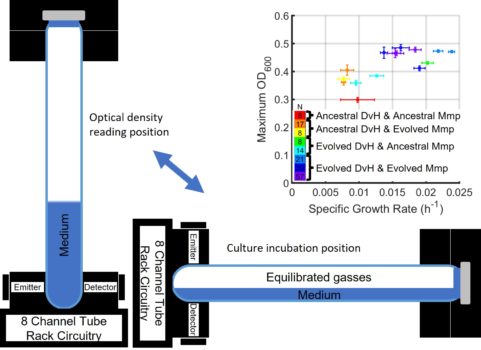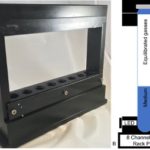An automated multiplexed turbidometric and data collection system for measuring growth kinetics of anaerobes dependent on gaseous substrates
Hunt, KA; J Forbes, F Taub, N Elliott, J Hardwicke, R Petersen, N Stopnisek, DAC Beck, DA Stahl; Journal of Microbiological Methods, [DOI]:10.1016/j.mimet.2021.106294



For decades, the cloudiness (turbidity) of a culture has been used to monitor the growth of microbes. Some microbes require well-mixed special gases to grow well. We developed and demonstrated an instrument that uses the same metric when monitoring by hand to track up to 64 cultures in parallel while still adequately mixing the gases for growth.
Automating data collection from growth experiments allows for well-replicated and, in turn, high-resolution measurements of growth rate and yield parameters. This device measures the growth behavior of anaerobes dependent on gaseous substrates for growth. Such organisms are often very slow growing, with doubling times of many hours. The device eliminates the need for extended periods of manual monitoring, during which time data is often compromised by operator fatigue or inter-operator variability. The new instrument automatically monitors and records the data from up to 64 culture vessels in parallel, improving the statistical power of experiments without increasing the labor required for monitoring over extended growth periods.
Many microbes and microbial communities have been found to grow by either producing or consuming gases, exemplified by the syntrophic growth of hydrogen-producing sulfate reducers partnered with hydrogen consuming methanogens. However, monitoring these cultures and determining growth parameters has been challenging since they grow slowly and require many measurements over days to weeks. We developed and demonstrated an automated optical density instrument (ODIn) for monitoring up to 64 of these cultures in parallel while still maintaining sufficient mixing to support growth comparable to manual methods. ODIn was essential to resolving the contributions of different mutants to the evolutionary improvements of syntrophic microbial communities dependent on interspecies hydrogen transfer. The collection of high-resolution data was a major factor contributing to the discovery of the statistical significance of minor changes in growth behavior; such data would otherwise be too labor intensive to detect using standard manual methods.
Contact:
David A. Stahl <dastahl@uw.edu>
University of Washington
